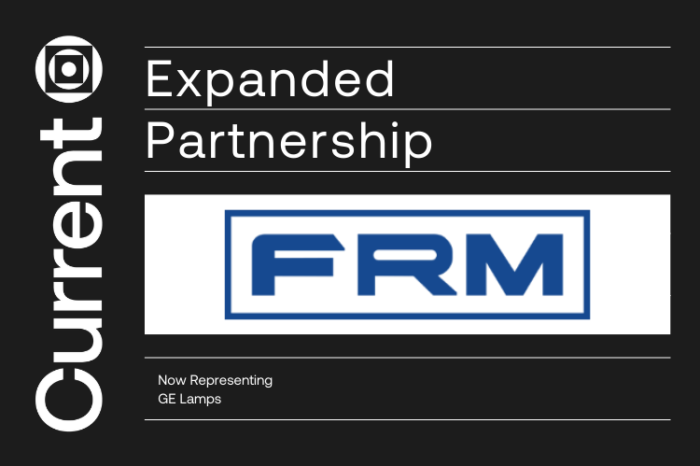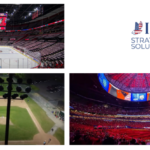Sports Lighting, A Growth Opportunity
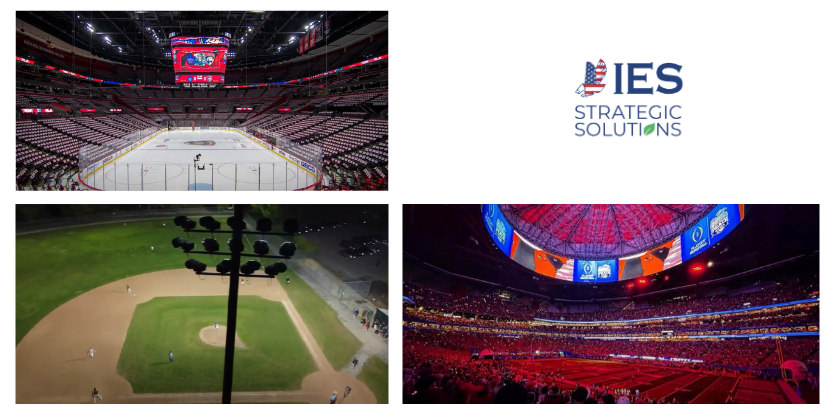 In a challenging market, especially for lighting, capitalizing on a niche that is supported by differentiated services can make all the difference. Boston-based Independent Electric Supply has found such a niche – sports lighting with a specialization in supporting municipalities, is enabling the company to play the field and support local communities.
In a challenging market, especially for lighting, capitalizing on a niche that is supported by differentiated services can make all the difference. Boston-based Independent Electric Supply has found such a niche – sports lighting with a specialization in supporting municipalities, is enabling the company to play the field and support local communities.
Linda Longo, Managing Editor for Residential and Institutional markets recently spoke with IES’s Strategic Solutions Group for US Lighting Trends, a Channel Marketing Group joint venture with Kerrwil Media, to learn more.
This article is an adaptation of an interview appearing in US Lighting Trends titled “Is Sports Lighting the Next Frontier? IES’ Strategic Solutions Carves Out a Lucrative Niche.“
For decades, electrical distributors and lighting agents didn’t pay close attention to the sports lighting category. If a town or school wanted to light their fields, for example, the typical solution meant installing pole-mounted metal halide floodlights and call it a day. But like everything else in lighting, things have become more complicated in the wake of LED light sources and lighting controls — but “complicated” is not a bad thing.
Mike Berube, VP/Sales, and Ed Colombo, Senior Sales of Independent Electric Supply’s (IES) Strategic Solutions team recently shared how they are turning this niche into a profitable category.
“It’s a unique business,” Berube said. “Ed and I were working as reps for four or five years when we started building this foundation, finding out from communities with state contracts what they were looking for and we saw opportunity there. As the older (metal halide) technology is starting to be phased out, communities are looking for options. For years, major brands using metal halide encompassed 90% of market share. We’ve been able to be successful over the past couple of years by using LED and integrated controls to bring the dynamic lighting that kids are seeing on TV in the NFL and Major League Baseball into the municipal space. That technology is available, but typically no one is showing it to customers — and that’s where we started leveraging that growth.”
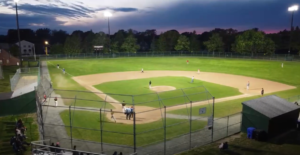
Great care is taken to make certain the newly installed fixtures direct light evenly onto the field and not impact any of the surrounding homes
Utilities hadn’t been paying much attention to the category either — until Berube and Colombo pointed out to them that times have changed since Title IX was passed in 1972 and they needed to update their standards.
“Title IX doubled the usage hours of sports fields. Prior to Title IX, a field’s baseline hours were around 800 a year, and that didn’t really meet the usage for a utility incentive. Fields would typically be used for varsity men’s sports and JV, but now they’re used by youth, men’s and women’s sports, varsity, and JV — plus communities are using these fields for non-sporting activities such as concerts and charity walks,” Berube explained.
“Another thing that expanded the sports lighting category was COVID,” Colombo remarked. “More people wanted to be outside, and there were requests for more fields. A baseball complex that used to be for the town league will now have teams coming in from all over because there are not enough fields available. Just the other day I went to a community that had four or five fields, but no light fixtures. They told me, ‘We have teams that want to lease our fields, but we need lights.’”
Having lights on fields is becoming a revenue generation opportunity for municipalities, according to Berube. “What we’re also seeing happening in sports in New England is a change from the traditional grass field to artificial turf,” he stated. “Once they put the turf on, they can triple the usage per year because there is no loss of use due to damage of the grass. If a community invests in turf, adding lights just makes sense.”
The caveat? Many times, installing a new LED lighting system with controls entails a much higher cost than most municipalities had budged for and there is resistance to change.
“We’ve done some calculations for the communities who ask, ‘Why would we go LED? We’re used to spending X per year and it’s in our budget for $25,000 a year for maintenance on the field lights.’ So, you look at that, and you look at the cost of one of these systems for a specific field – which, if it is a brand new system with controls, could cost $65,000 or $75,000 whereas a retrofit might be $20,000. We explain how we’re able to bring down that cost with utility incentives to make the new system cost almost the same as what they already budgeted for in most cases,” Berube explained. “We’ve also worked with some of those utilities to put on-bill refinancing together, so the community doesn’t have to come up with the capital expense; it’s basically a 0% loan on their electric bill.”
Berube elaborated, “With on-bill repayment (OBR), the utility looks at an opportunity for savings. They might have a large savings goal in the community, and field lighting might be part of that. Because of the benefit to both parties – the utility and the community – in taking it off the grid, they come up with a mutual agreement to put this on their electric bill and pay it that way. So, if their bill is normally $1,000 a month, they’re going to save $500 a month by going to LED with controls, and the bill will stay at $1,000 for six years. So they’ll still have the same bill, but they will have brand new lights and controls. It’s a mutually beneficial situation.”
Colombo added, “We just did the city of Pawtucket, Rhode Island. It started out with us looking at a couple of fields, but when we started talking about OBR, they told us to look at all of their fields. We did every single field in Pawtucket – and there were 22 of them – and they put it on OBR, plus there was rebate money available.”
“When sports lighting comes up as a project for a community, no one ever looks at utility incentives or an opportunity. Because of our relationships with utilities in New England, we know they are having to struggle to find efficiency goals based on where codes are going,” Berube said. “I think utilities across the U.S. are going to start having more issues on the electrification side, and large savings projects like this help support the grid and help communities stay away from blackouts and brownouts. We do a lot of electric vehicle projects as well, that’s another big initiative and a lot of federal infrastructure money is going into that space.”
There is a lot more involved than just replacing legacy fixtures with LED versions. “We sit with the owners to discuss the field’s usage, and we work with engineering firms and soil sample engineers regarding pole heights and EPA wind loads,” Berube said. “For retrofits, our concern is weight. Can that existing pole handle the weight of what’s going up versus what’s there. Those are areas where you have to know what you’re looking into, which is why we align ourselves with Cooper Lighting and their Ephesus system, Spring Lighting Group’s (SLG) full system, and Jademar, which has great optics and controls that point the light onto the field without affecting any houses around it. Depending on the application, each manufacturer has something a little different.”
Colombo added, “Lamp light, optics, and spill light — all of that is taken into consideration. If we’re out in the middle of nowhere and there are no houses, we don’t have to worry; but we’ve done a couple of fields in the middle of a neighborhood, and you have to be careful. When retrofitting, there are a lot of calculations, such as measuring the girth of the existing pole and the height. We might have to put on new brackets or utilize the existing brackets with clamps; there are a lot of options.
Right now, retrofit is a big market. With metal halide going away, lamps and ballasts are getting expensive, and you can’t find them easily.”
Naturally, success in the sports lighting niche is not just what you know, but who you know. “We’re involved in buying groups like Sourcewell and AD and we’re a state contract vendor in Massachusetts for area lighting,” Berube stated. “We’re also in Rhode Island, New Hampshire, Maine and Connecticut. We’re already involved in these communities,” he said, adding that knowing the nuances of each municipality is a benefit.
“We’re well ahead of people who want to dive into this; and when they do dive into this, there can be problems if they’re not looking at every little angle,” Colombo cautioned.
Technology has made double-checking every angle of the installation easier, too. “Drones are very helpful for getting a good view of the brackets that are up on 80-ft. poles,” Colombo said.
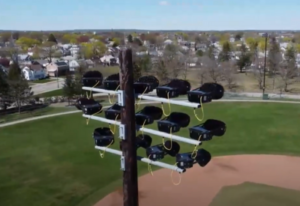
Berube and Colombo use drones to get close to the installed fixtures and check for any loose brackets, wires, and connections.
“We can use a drone and an iPhone and drive it two feet away from a bracket that we would never be able to see without getting a truck. We can see if parts are rusted or if we need to do something different with the clamps, and whether the wires are intact at that level,” Berube added. “We use the drones before and after an installation to double-check everything, take pictures, and catalog everything for the account so they know what was there and why they made the investment. It’s part of the sales process, but also part of the takeaway for the community. In many cases, we do a before and after video for the client so that they have something to show when taxpayers or the community ask, ‘Why did we spend all this money?’ Well, here’s what it looked like before, and here’s what it looks like now.”
According to Berube and Colombo, a lot of utilities are currently building their next three-year DPU plans. “Every three years the utilities need to come up with new initiatives, and sports lighting is starting to become more prevalent and being added to these three-year plans,” Berube remarked. “We’re seeing more and more manufacturers starting to look at sports lighting as an option in their product offering. The market is starting to change, and we’re just a little bit ahead of it.”
Thoughts
- Thank you, Linda and IES for sharing these insights.
- The sports lighting market is a niche for many. Typically, it is a bid and buy project for distributors. IES is proactively pursuing, creating, and closing these deals. Are they successful? They are keeping a number of electrical contractors busy … hence the answer.
- While increased field usage and safety should be reasons for field lighting upgrades, the unique usage of utility rebates can make this a “no brainer” for municipalities, which are typically budget-challenged. It helps that New England is a high utility cost but progressive utility rebate area. There are other parts of the country where the same model can be effective.
- If you are interested in learning more and want to network with IES, click here to connect and DM Mike on LinkedIn.
If you are involved in lighting, I encourage you to subscribe to US Lighting Trends to receive our twice a month eDigest and our twice a month Product Watch. Over 30,000 US lighting specifiers, electrical contractors, electrical distributors, reps / lighting agents and distributors receive US Lighting Trends.
If you’d like to advertise or have your project featured in US Lighting Trends, reach out to me.







